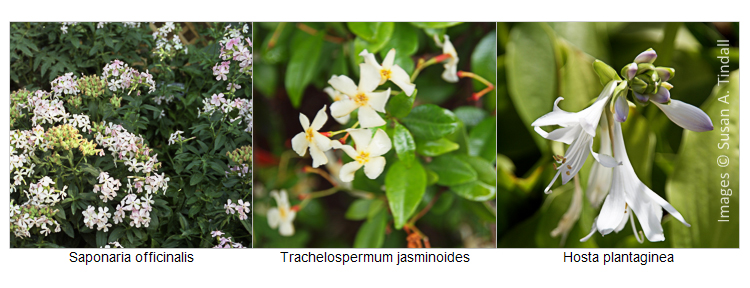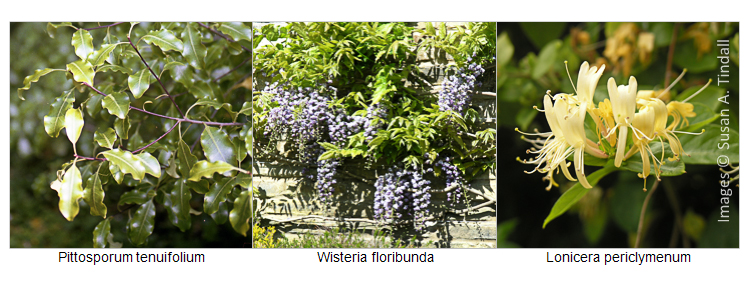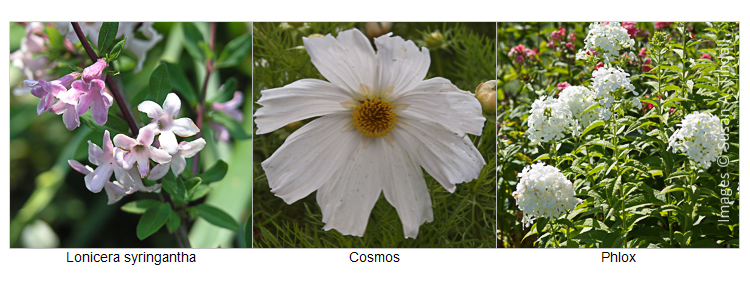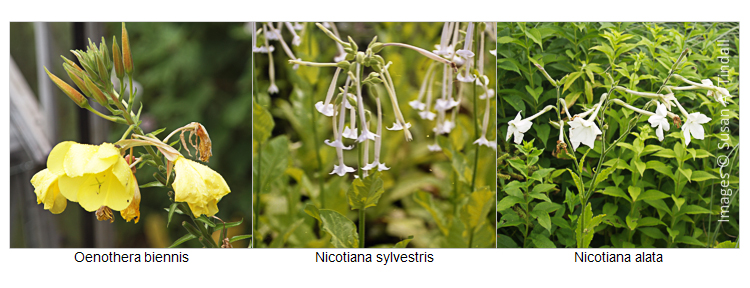Some plants emit their fragrance at night. These fragrances are generally intense, even memorable, in the darkness adding both simplicity and mystery to the experience. In practical terms the main night-pollinators in the UK are moths. These insects are attracted by scent at the ‘sweet’ end of the fragrance spectrum. The ‘night-time plants’ therefore have honey, jasmine or honeysuckle scents.
It helps to site these plants in places that are protected from strong winds, so the fragrance can hang in the air. Plants can be positioned by a window that is opened on a warm evening. Where there is a front garden, include a night-scented plant so that late in the evening you are greeted with an exquisite fragrance as you approach your front door.
Plants to consider:
Nicotiana alata (Jasmine tobacco) and Nicotiana sylvestris (Mountain tobacco) are tall plants that flower from July to September. Just two or three of these inexpensive plants, generally grown as annuals, can provide a heavy, delicious fragrance. There are a number of smaller cultivars, some of which will carry some scent but the species are the best, and their white tubular flowers are also visible in the dark. It is possible to grow them in a container. Oenothera biennis (Common evening primrose) opens its fragrant flowers at dusk and can be allowed to naturalise in a wilder part of the garden.
Much more modest in height, Saponaria officinalis (soapwort) has a sweet fragrance, especially noticeable in the evening. It is likely to flower in July. If elegant foliage is required Hosta plantaginea (the August lily) is fragrant at night, flowering in August.

There are several climbers which are night fragrant and these include the desirable, borderline tender Trachelospermum jasminoides (Star Jasmine) and Wisteria floribunda (Japanese wisteria). Lonicera periclymenum (the common woodbine) is also worth considering. Usually grown for the beauty of their foliage but having flowers in April that have an exceptional honey fragrance, Pittosporum tenuifolium and its many hybrids are excellent. Lonicera syringantha (the lilac honeysuckle) is a late spring flowering shrub with a sweet fragrance that is very noticeable in the evening and night. Since the fragrance of these plants is generally carried for several yards they can easily be incorporated in planting that is grown for its flowers or foliage effect in the daytime.

Finally, in order to provide some visual interest after dark, grow a few white flowers that will be attractive at night. These could include white Cosmos and white Phlox, the latter is also fragrant and attracts hawk moths at night.
 Further details of all of the plants mentioned in the article are available in our Garden for pleasure plant finder, just click here.
Further details of all of the plants mentioned in the article are available in our Garden for pleasure plant finder, just click here.
Suppliers from our supplier directory who supply many of the plants mentioned in this article, or hybrids of them, include Crocus.co.uk.
Enjoy!
Susan A. Tindall.

